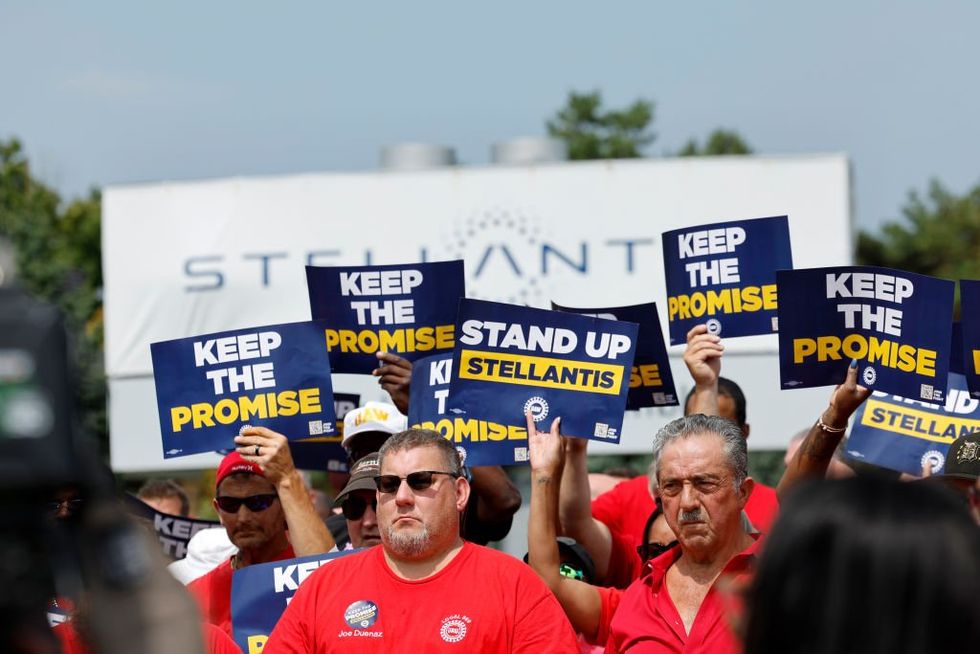Foreign owner runs Dodge, Ram, and Jeep into the ground

The world’s fourth-largest automaker is in trouble.
Stellantis, the Netherlands-based conglomerate that now owns iconic American brands Chrysler, Ram Trucks, Dodge, and Jeep, anticipates disastrous third-quarter sales figures.
Dodge’s reputation for performance has also been squandered. In what world does it make sense to get rid of the Charger and the Challenger?
On Wednesday, the company reported sales 20% lower than the third quarter of 2023, a decline that puts them down 17% for the year.
Investors are heading for the exits.
Worse than COVID
Although the company will not post global Q3 sales until the end of the month, there’s little reason to expect an upswing. Bloomberg reports that its production in Italy has cratered, dropping 41% so far this year to about 238,000 vehicles.
That’s fewer than the amount of vehicles it made in 2020, when the COVID pandemic shut down its plants.
More dire numbers:
The stock price dropped 12% this week and is down 40% so far this year. At the beginning of the year, the company’s market cap was $70 billion. Now it’s $36 billion, a $34 billion drop in value in only 10 months.
A bad year for Tavares
This is a drastic change in fortunes. Last year, Stellantis was one of the most profitable full-line manufacturers, with double-digit margins, and Carlos Tavares was hailed as one of the best CEOs in the business.
But this year, he’s managed to turn everyone against him: his dealers, his unions, his employees, and even the Italian government. The board is also actively looking for a new CEO when his contract expires in 2026.
And it’s possible he won’t even last that long. The board of directors may have to buy him out, if only to prove it’s upholding its fiduciary duty.
I could’ve had a V8!
Consider one of the company’s most glaring missteps: removing the Hemi V8 from its two most valuable brands, Jeep and Ram, while pouring more money into electric vehicles people just aren’t buying.
Dodge’s reputation for performance has also been squandered. In what world does it make sense to get rid of the Charger and the Challenger?
Dodge could have sold the Challenger, on that platform, for another 10 years with competitive volume against the Mustang — especially with no more competition from the Camaro.
The Challenger and the Charger were moneymakers; the profit per car when you have the same platform for 20 years is unbeatable. Sadly, a combination of restrictive government regulations and an inability or unwillingness to understand the American market did them in — and Dodge may soon follow. Stellantis clearly needs a Lee Iacocca.
It’s done no better with its Italian sports car brands, removing both Fiat and Alfa Romeo performance models from the U.S. market. Maserati may also not be too long for this world in the Stellantis portfolio.
To help cope with this downturn, Stellantis is planning a 25% reduction in logistics expenses for the second part of this year.
Union woes
Drastic cuts in labor costs are also in the works, which will no doubt worsen the company’s already tense relations with the union.
The UAW put immense pressure on Stellantis during the last strike. After reaching a settlement, the company ended up moving some production to Mexico to save money. Last week, Stellantis filed nine lawsuits against the UAW seeking to block any attempt to strike over commitments made in the 2023 contract.
Brain drain
There’s also been a concerning departure of executive leadership under Tavares. Key U.S. personnel like Jim Morrison, Tim Kuniskis, and a few other top talents have left the company, taking decades of experience with them.
That Tavares has allowed this to happen suggests incompetence, indifference, or arrogance. We’ve certainly seen the latter before from DaimlerChrysler, when German executives overestimated their understanding of the U.S. brands under their control. If only Stellantis could learn from the past.
This week, Stellantis employees — a few of whom I know personally — were offered early buyouts, which means more quality, long-term talent will leave the company.
Changing his tune
What’s most disappointing about the current state of Stellantis is that Tavares had a promising enough start.
He often said the truth about EVs and warned EU politicians about the idiocy of EU 7 emission regulations. He was pretty good at walking the line between being “green” and seeking a profit.
In the past few months, however, he seems to have changed his tune — at least if you take his public statements about readiness to “transition” the industry to new sustainability standards. Stellantis is betting it all on EV, while other companies are moving to a mix of hybrid, plug-in hybrids, and EVs. People are talking behind the scenes, and it’s clearly going badly after July and the summer sales numbers, which were horrible.
Stellantis is hoping new model launches — a total of 20 across the company’s vast array of brands — will help the automaker in the second half of 2024. The question is, will it find the leadership it needs to handle these correctly? We will keep our eyes on things and keep you posted.










